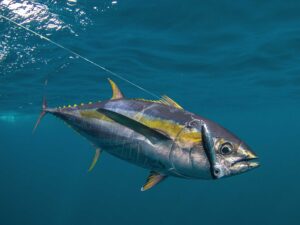
I am a commonsense kind of guy. I’m pretty sure the sun will rise tomorrow in the east and will keep that up until, in the words of Shakespeare, I “shuffle off this mortal coil.”
It also seems to be common sense that in the natural world there are predator and prey relationships that have developed over tens of thousands of years. Mankind’s efforts to disrupt those relationships with our ongoing exploitation of fisheries worldwide are only a blink of the eye at the end of that timespan. In the world of fish, it seems that the relationship of predator to prey is pretty straightforward.
There are some predators (fish and other critters that eat smaller fish), and there are lots and lots of prey (the little ones that get eaten). There are many reasons this has developed this way. The primary ones are that there are lots of prey because the predators need to eat and because there is safety and longevity in numbers. Pretty darn simple to a commonsense kind of guy.
Then earlier this year, a study came out that, to a great extent, turns this simple theory on its head. The study was done by a group of fisheries biologists who have a long list of letters after their names. So, who am I to argue with all that knowledge? Common sense says I should not, and common sense says I should. I’ll follow common sense!
The study is called “When does fishing forage species affect their predators?” The study was conducted by seven highly regarded researchers. If the order of their listing in the document has any meaning, then Ray Hilborn Ph.D. appears to be the lead researcher. There are a number of conclusions from the study, but for me the most important are: The predator rate of increase is uncorrelated with forage fish abundance; forage species are affected much more by environmental conditions than by fishing; and predators often take small forage fish that are unaffected by fishing.
I have to say that I question the first conclusion, as it just does not pass the “common sense” smell test for me. For anyone getting a degree in marine biology, the trophic pyramid has to be one of the basic building blocks.
The fish at the top are the apex predators, and those at the bottom are the forage. Those of us who fish likely focus on the sport-fish apex predators, but there are many different kinds that make up the ecosystem. We know that if you take away all the forage, there will be no predators. With that as a basis, there has to be a direct correlation between these two parts of the trophic pyramid. Can some level of removal be tolerated by this relationship with minimal impacts? This research says it can, but the question becomes: Where is the tipping point? How do you account for all the ecological services provided by the forage?
Again, it seems to be common sense that forage can be affected more by environmental conditions than by fishing. We see this every year with some species seemingly disappearing only to reappear again in fully restored numbers. The natural world works this way, but that process evolved in a world where man had little or no impact. Should removals be done at the highest level possible or at some lower precautionary level? Both fishing and environment impact forage, but we can only control fishing removals.
The primary example used to support the conclusion that predators usually take small forage that are unaffected by fishing is one that I have some level of familiarity with. They based this conclusion on a study of the stomach contents of striped bass, which showed that the bass ate primarily juvenile menhaden. Really? It must have been blind luck catching all those big striped bass on large menhaden year after year. At certain times of the year, juveniles will be predominant, but not all year. And last time I checked, it takes the big ones to make small ones, so there is an impact on juveniles from adult removals. This research, to a great extent, was conducted to counter research done by the Lenfest Ocean Program called Little Fish, Big Impact.
The Lenfest research used traditional trophic models that the new researchers said did not account for natural variations. I will let the Ph.D.s point fingers at each other, and I will return to commonsense thinking. Was the new research done to support the forage-extraction industry, or was it done out of pure curiosity? Most believe the former. Truly valuable research is done without conclusions being predetermined or desired.
Does this mean there should be no fishing extraction of forage fish? Not at all. But until science can determine and quantify all the ecosystem roles filled by forage fish, the fish should be managed under the “precautionary principle.”









